When it comes to producing legendary beats, the importance of bass cannot be overstated.
It’s the heartbeat of your track, the rhythmic pulse that drives the music forward, and the sonic glue that binds everything together.
However, achieving the perfect bass sound isn’t just about playing the right notes 一 it’s also about how those notes are shaped and defined in the mix.
That’s where equalization (EQ) comes in.
Knowing how to EQ bass correctly is vital for creating a mix that is balanced, clear, and sonically pleasing.
In today’s article, we’ll be breaking down:
- The role and nuances of bass in hip-hop production ✓
- Why EQing bass is crucial ✓
- Types of bass instruments used in digital production ✓
- How to define & understand bass frequencies ✓
- The art of EQing bass ✓
- Working with different types of EQ, like high-pass & low-pass filters ✓
- Techniques for managing the low end of your mix ✓
- How to balance bass with other instruments ✓
- Troubleshooting common EQ issues ✓
- Advanced EQ techniques ✓
By the end of this guide, you’ll have all the tools and knowledge you need to EQ bass like an absolute boss.
You’ll be equipped with expert techniques that can transform your bass sound and take your mixes to a whole new level.
So, let’s dive in…
Table of Contents
- The Role of Bass in Hip-Hop
- Why is EQing Bass Important?
- Types of Bass Instruments
- Defining Bass Frequencies: Sub Bass to Mid Frequencies
- Bass Sounds & Tones
- Working with Different Types of EQ
- EQing Bass: High-Pass Filters & Low-Pass Filters
- Utilizing EQ Settings for Different Bass Tracks
- Balancing Kick Drum Sounds with Bass Frequencies
- How Sidechain Compression Helps in Mixing Bass & Kick Drum
- The Role of Frequency Response: When Your Mix Lacks Clarity
- Bonus: Advanced EQ Techniques
- How to EQ Bass: Final Thoughts
The Role of Bass in Hip-Hop
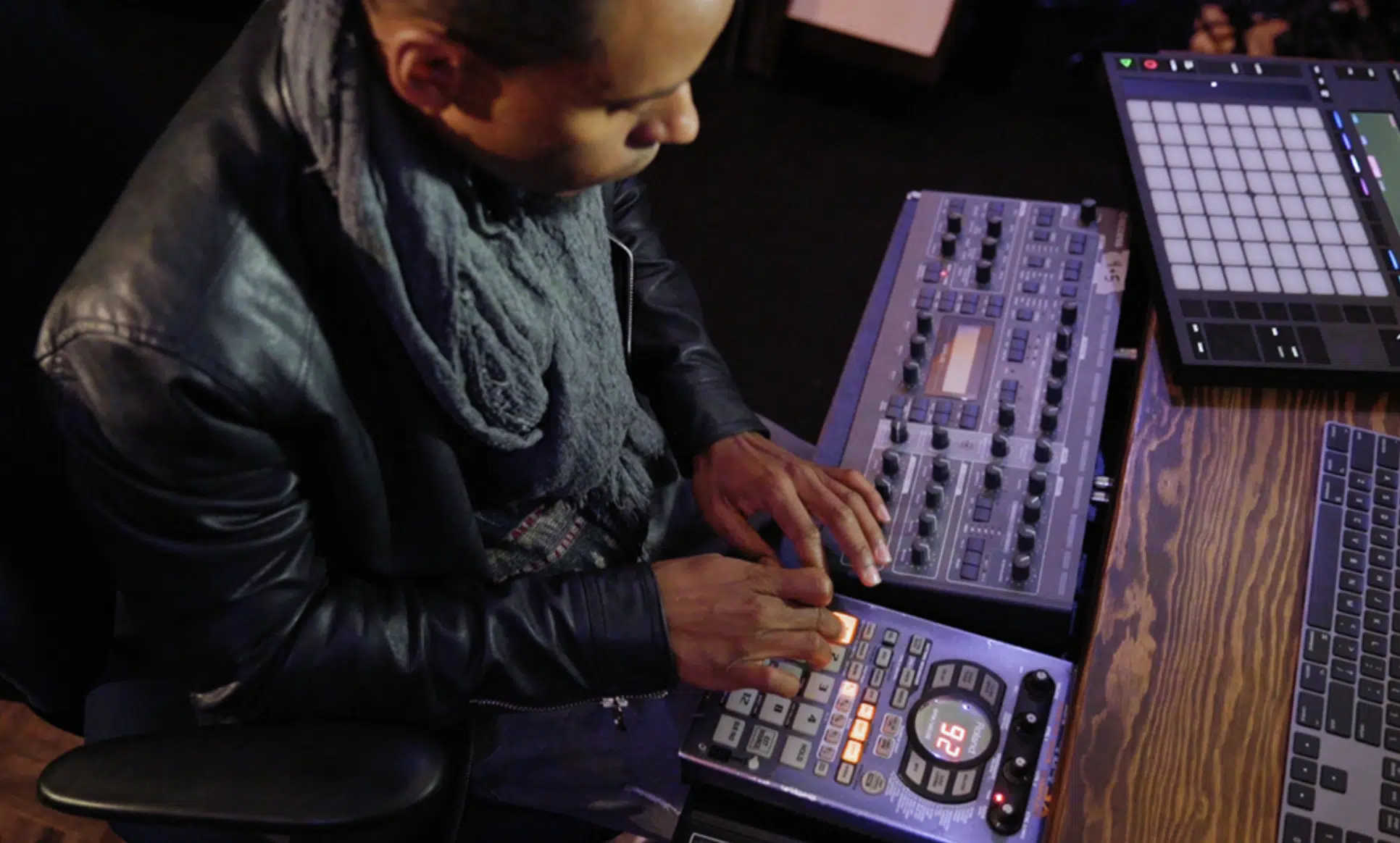
The beauty of hip-hop music largely lies in its rhythm and groove, and that’s where the bass plays a pivotal role.
Whether it’s a sub-bass pulsing beneath the surface or a bass guitar laying down a groovy line, the bass brings depth and power to your tracks.
But what makes the bass unique in hip-hop?…
Firstly, it’s the diversity of the bass sounds being used.
From the deepest 808 sub bass to a funky slap bass guitar, hip-hop embraces a wide variety of bass sounds.
And it’s this diversity that gives producers a rich sonic palette to draw from.
However, the bass in hip-hop is not just about the low end.
It often occupies a significant portion of the frequency range 一 extending into the mid-frequencies.
This wide frequency range is what gives hip-hop bass its distinctive character.
Why is EQing Bass Important?
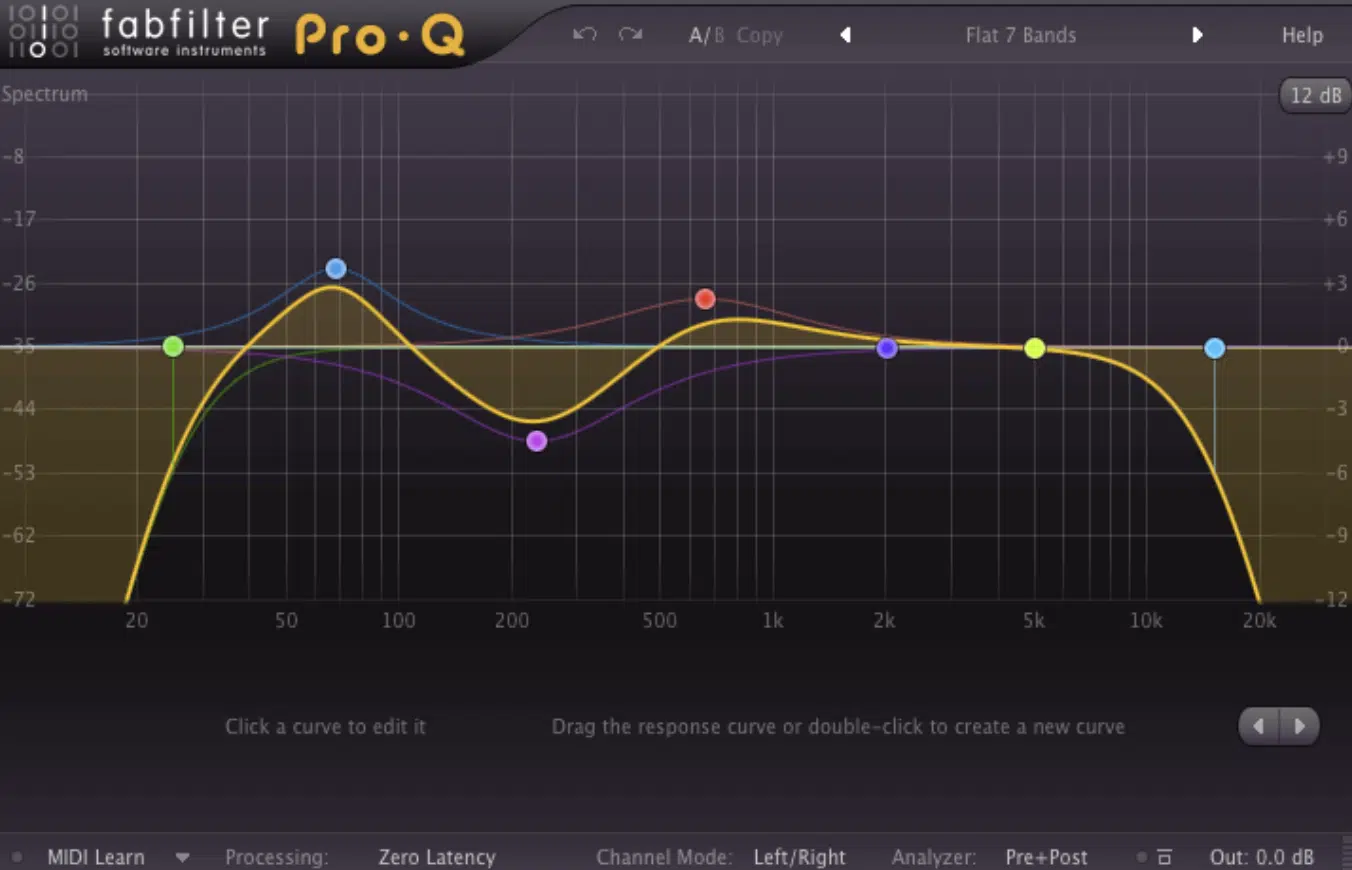
But why is it so important to know how to EQ bass?
Well, for starters, EQing the bass allows you to shape the sound to fit perfectly in your mix.
By manipulating the bass frequencies, you can ensure the bass doesn’t overpower other elements in the mix.
Additionally, knowing how to EQ bass can help reduce muddy sounds and increase clarity in your mix.
This is particularly important in the low end 一 where too much bass can create a dense mix that lacks definition.
Finally, knowing how to EQ bass is critical for managing the dynamic relationship between the bass and kick drum.
By sculpting the frequencies of these two elements, you can ensure they work together harmoniously, rather than competing for space in the mix.
Types of Bass Instruments
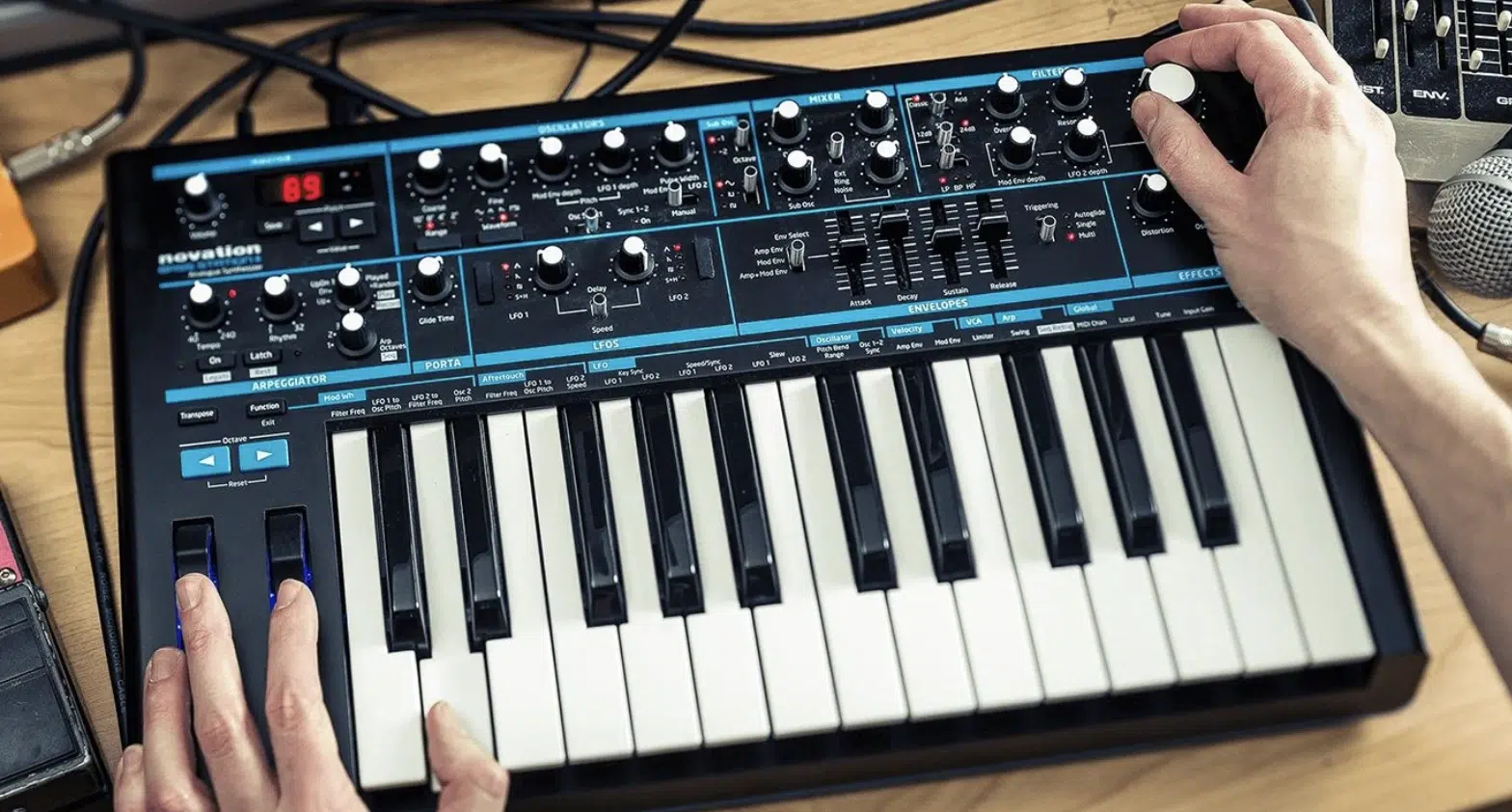
When it comes to digital music production, you have a plethora of bass instruments at your disposal.
From sampled bass guitars to synthesized sub-bass, the possibilities are nearly endless.
Among the most popular are synth basses, which offer a wide range of sounds 一 from warm and round to sharp and edgy.
Then you have the bass guitar (a staple in many genres) but also a common choice for hip-hop tracks seeking a more organic sound.
Of course, we can’t forget the mighty 808 sub-bass; a defining feature of many hip-hop tracks.
Its deep, booming sound can fill the low end of a track and provide a powerful rhythmic drive.
Defining Bass Frequencies: Sub Bass to Mid Frequencies
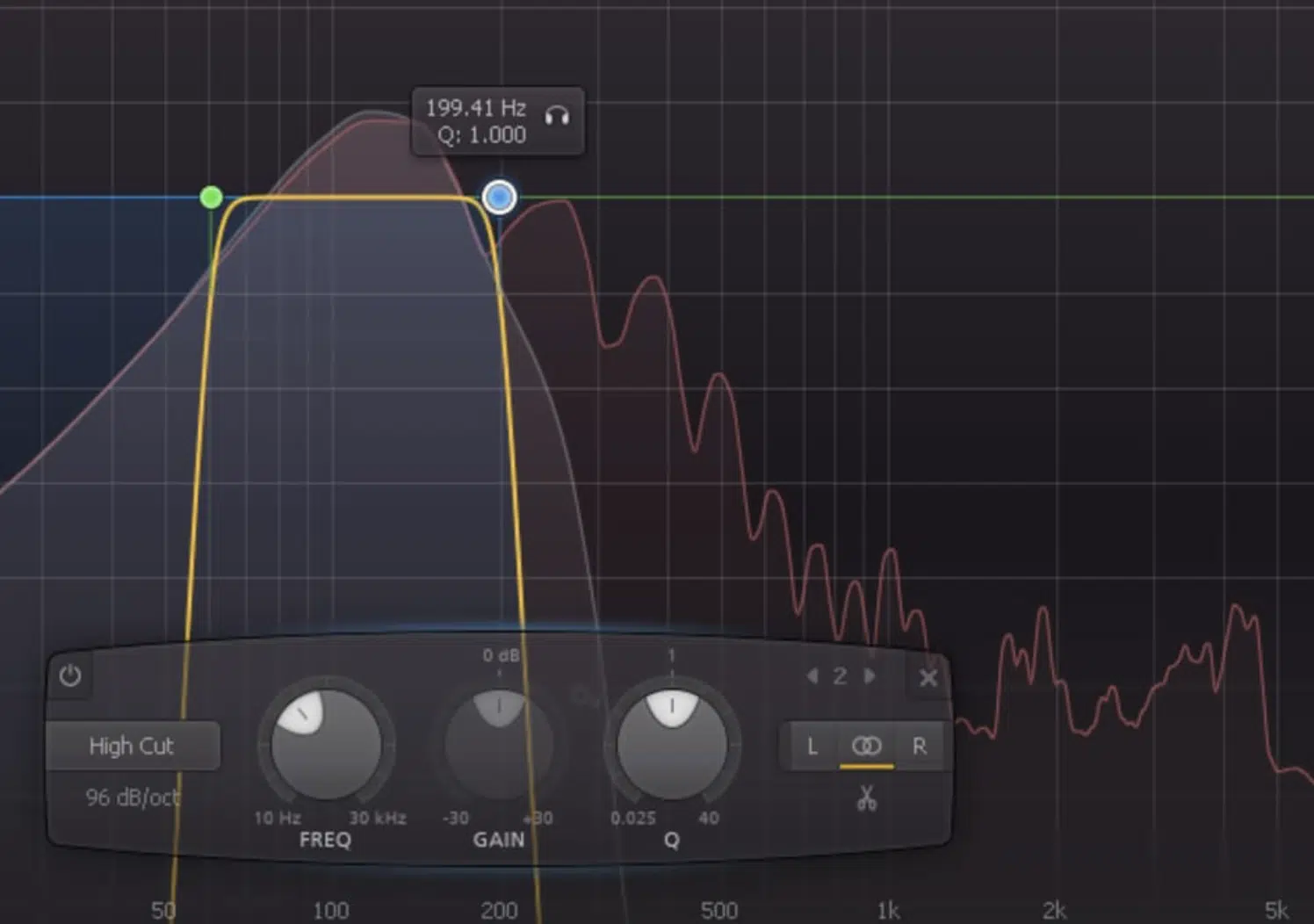
60-250 Hz
But what exactly do we mean when we talk about ‘bass frequencies?’
In music production, the term ‘bass’ typically refers to sounds that fall within the lower frequency range 一 specifically from about 20 Hz to 250 Hz.
Within this range, we can break things down further:
The sub-bass (20 to 60 Hz): The lowest frequency range and is where you’ll find the deep, rumbling sounds of a subwoofer.
This is the realm of 808s and other low-end instruments.
Above the sub-bass, we have the bass frequencies (60 to 250 Hz): Where most bass guitar parts reside.
These frequencies give weight and warmth to the music.
The bass can also extend into the low-mid frequencies (250 to 500 Hz), which can add body and thickness to the bass sound, but not high frequencies.
Bass Sounds & Tones

The beauty of bass lies in its versatility.
From the deep, booming sound of an 808 to the warm, melodic tones of a bass guitar, the types of bass sounds used in music are vast and varied.
When we discuss the ‘tone’ of bass, we’re referring to the quality of the sound, which is influenced by factors such as:
- The instrument used
- The specific playing technique
- The EQ settings
But the secret to a great bass tone lies in the balance between all the frequencies.
A good bass sound should have enough low end to provide depth and power, but not so much that it overwhelms the rest of the mix.
At the same time, the mid and upper frequencies should be balanced to ensure the bass can be clearly heard on all playback systems.
-
EQing Bass Guitar
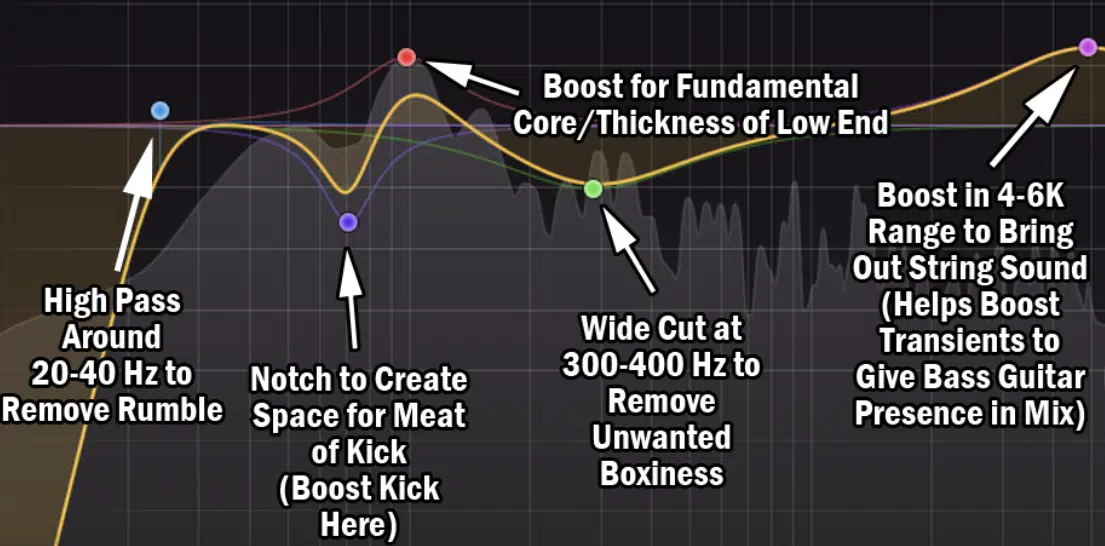
When learning how to EQ bass guitar, start by identifying the frequency range where your bass guitar primarily resides (typically between 50-250Hz).
Understanding this frequency range is the key to effectively manipulating the sound of bass guitar EQ.
The 50-100Hz area contributes to the bass guitar’s sense of weight and power.
Boosting in this region can make the bass feel fuller but be careful… excessive boosting can lead to a mix that feels and sounds muddy or boomy.
For more definition and clarity, focus on the 100-250Hz range.
A slight boost here can help your bass guitar successfully cut through the mix.
However, cutting in this region can also be useful to carve out space for other midrange instruments, such as guitars or keyboards.
When you’re trying to EQ bass guitar, knowing these bass frequency ranges is crucial.
Working with Different Types of EQ
The type of EQ you choose can greatly impact the sound of your bass.
Dynamic EQs and analog mixers are two common choices 一 each with their unique characteristics.
- Dynamic EQ
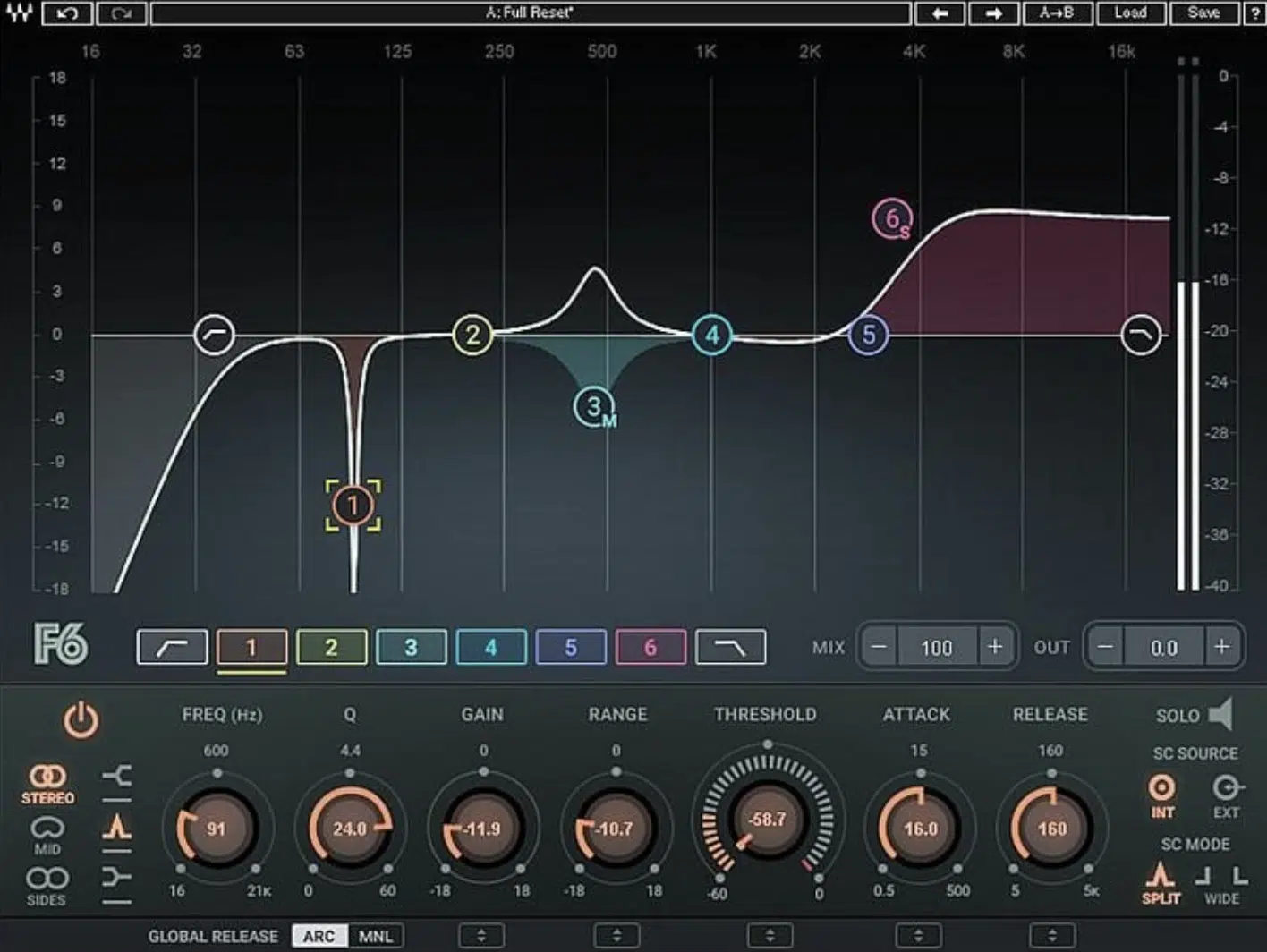
Dynamic EQ is essentially a mix of EQ and compression; adjusts the EQ curve in response to the signal level.
This makes it an excellent tool for controlling inconsistent bass levels.
For instance, if your bass guitar has notes that spike in the low-mid range, a dynamic EQ can tame those spikes without affecting the other frequencies.
- Analog Mixers
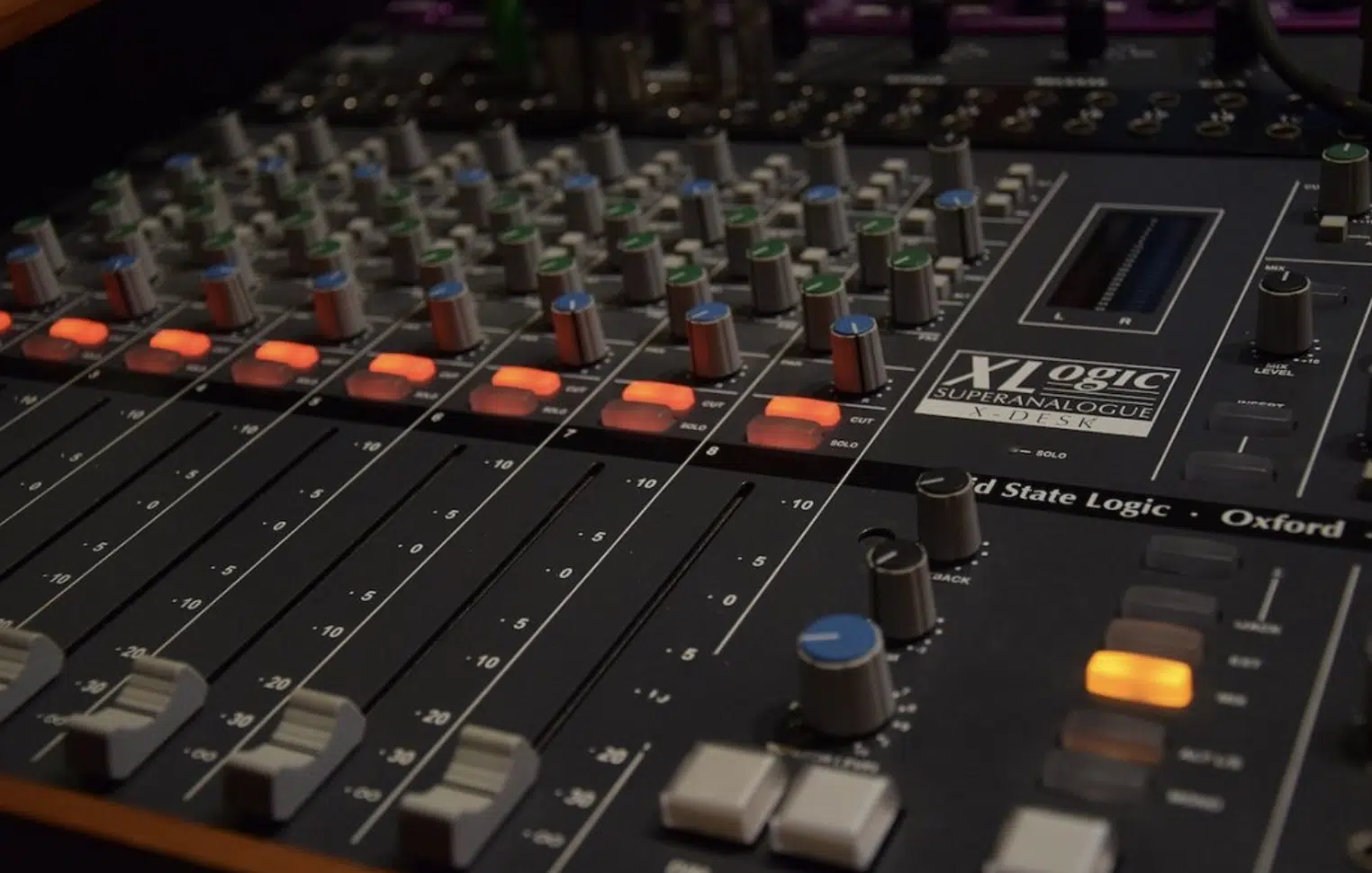
Analog mixers are known for their warmth and musicality.
An analog EQ, such as the Pultec EQP-1A, is famed for its ability to both boost and cut the same low frequencies.
It creates a resonant peak that adds punch to the bass while maintaining clarity in the mix.
Regardless of the EQ type you use, remember that EQing is about balance.
Each boost or cut should serve the vibe of the song and help create a cohesive mix.
EQing Bass: High-Pass Filters & Low-Pass Filters
High-pass and low-pass filters are powerful tools in EQing bass.
They enable you to manage the frequency range of your bass track, controlling which frequencies are emphasized and which are attenuated.
- A High-Pass Filter
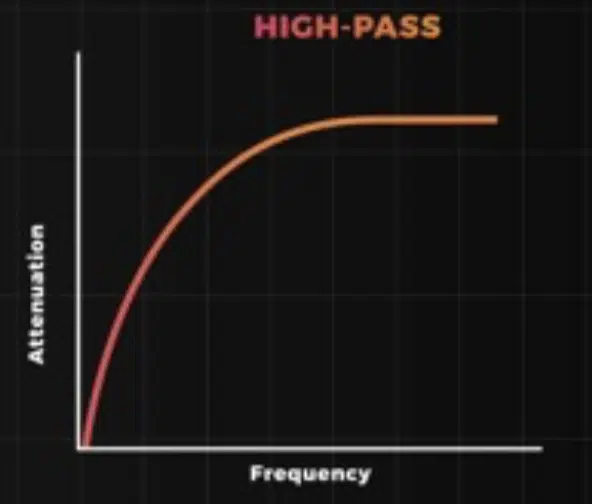
A high-pass filter cuts frequencies below a certain point, allowing only the higher frequencies to pass.
This might seem counterintuitive for bass instruments, but it can be useful for cleaning up unnecessary low-end rumble and making room for the kick drum.
If you want to learn everything about high-pass filters, we’ve got you covered.
- A Low-Pass Filter
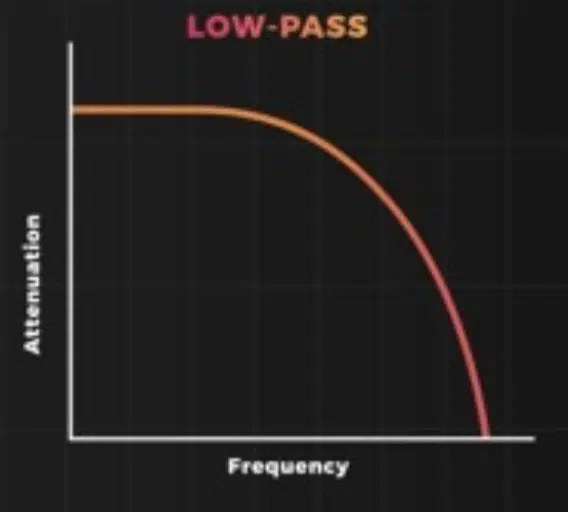
A low-pass filter cuts frequencies above a certain point and allows the lower frequencies to pass.
This can help ensure your bass remains focused in the low end and doesn’t interfere with higher-frequency instruments.
When using these filters, remember that steep slopes can result in phase issues.
Therefore, gentle slopes are typically preferred for natural-sounding results.
If you’d like to learn everything about low-pass filters, we’ve got you covered on that end too.
-
The Kick & Bass Relationship
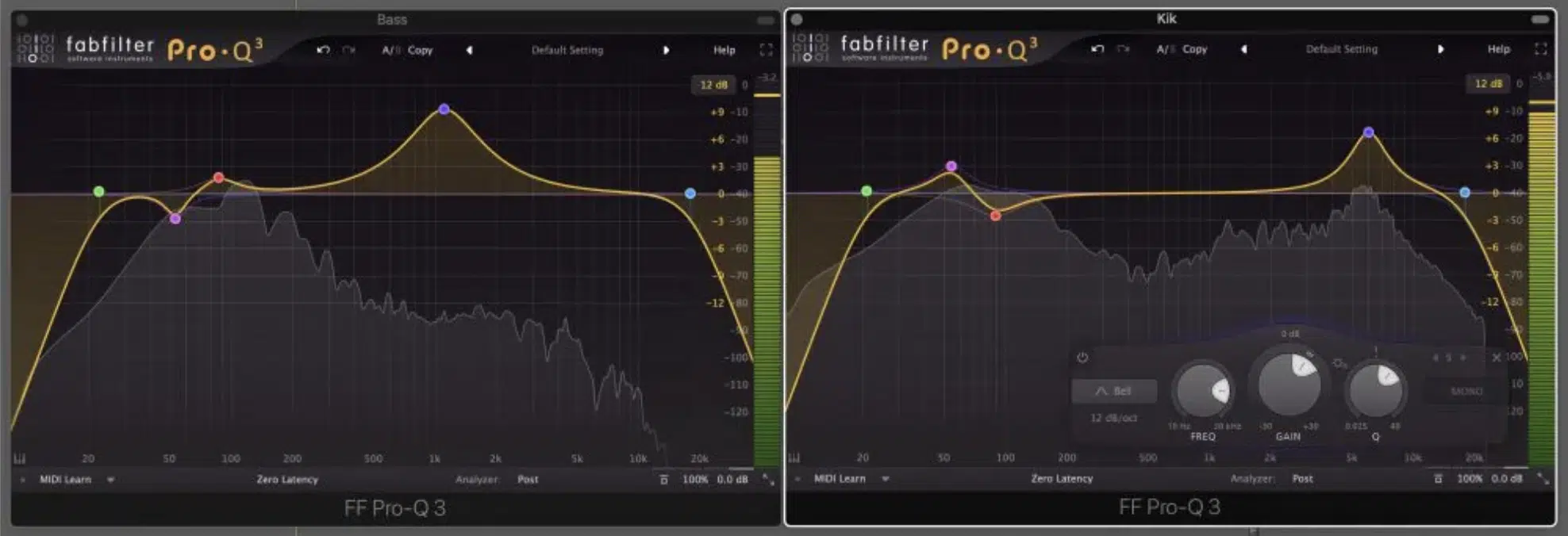
Bass EQ on the left and Kick EQ on the right. Complimentary boosts and cuts help the two parts cut through at the frequencies that benefit them most.
In hip-hop production, the kick and bass are two crucial elements that work hand-in-hand.
They need to be EQ’d strategically to ensure they complement each other, rather than fighting for the same frequency space.
Start by identifying the fundamental frequency of your kick drum.
If it’s in the same range as your bass, consider carving out a bit of space in your bass track at that frequency using a narrow EQ cut.
This will help your kick punch through the mix without clashing with the bass.
But it’s not just about fundamental frequencies 一 timing is crucial too.
If your kick and bass are not hitting at the same time, they can create a flabby, uncoordinated sound.
NOTE: To tighten up the rhythm, try nudging the bass track slightly to line up with the kick.
-
Managing Low End: Avoiding a Muddy Sound
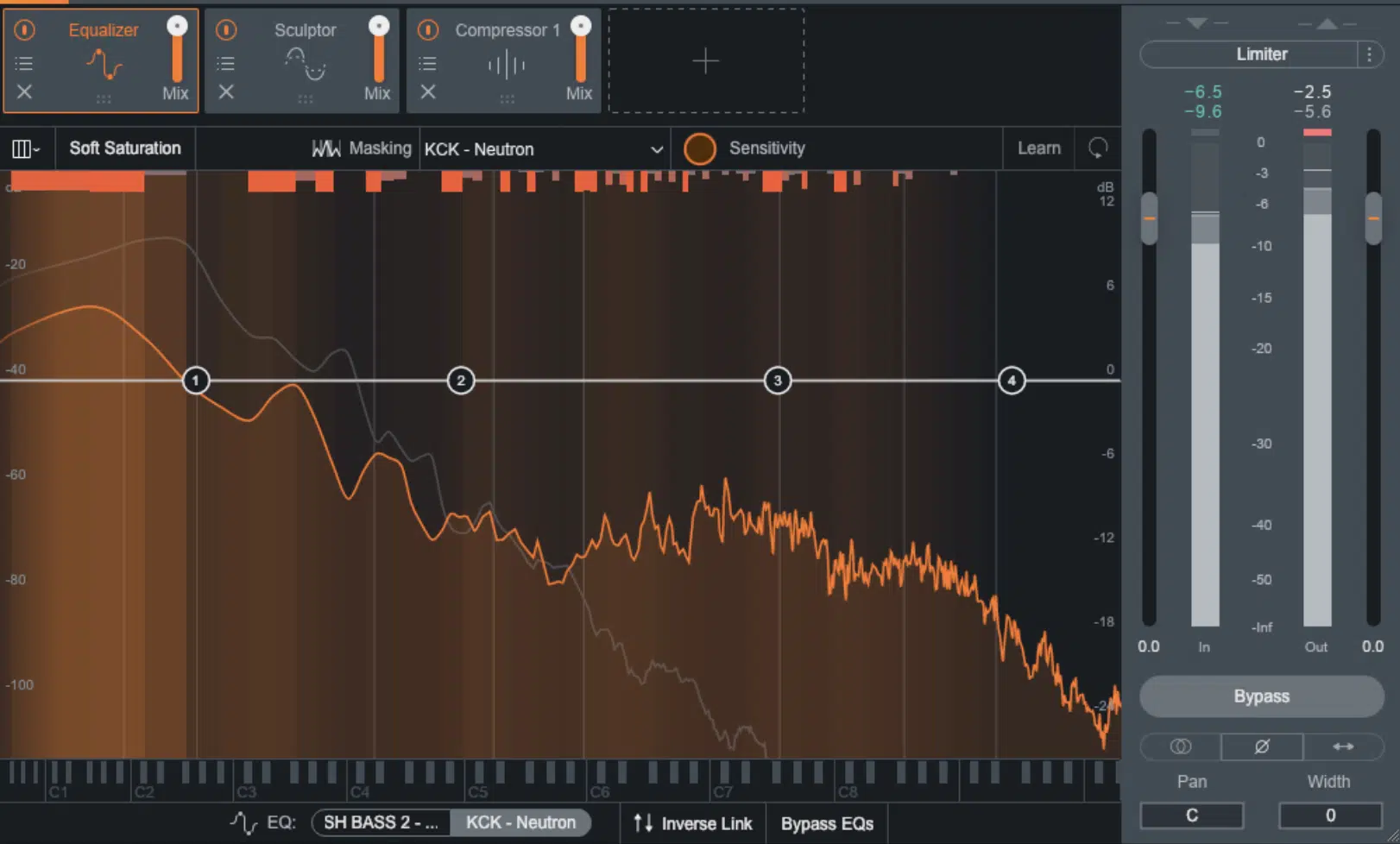
Above, you can see heavy masking between the kick drum & sub-bass.
A muddy sound occurs when there’s too much happening in the low frequencies.
This can be managed by utilizing high-pass filters on instruments that don’t need to be present in the low end.
Removing unnecessary frequencies helps clean up the mix 一 allowing your bass instruments to shine.
Careful volume balancing also helps avoid a muddy mix.
Remember, it’s not just about which frequencies are present, but how loud they are.
Using a spectrum analyzer can be beneficial to visually see where frequencies might be overcrowding and adjust accordingly.
Lastly, using mono for low-frequency sounds such as bass and kick can assist in maintaining a clean and powerful mix.
Low frequencies in stereo can cause phase cancellation issues and lead to a less impactful sound.
Utilizing EQ Settings for Different Bass Tracks
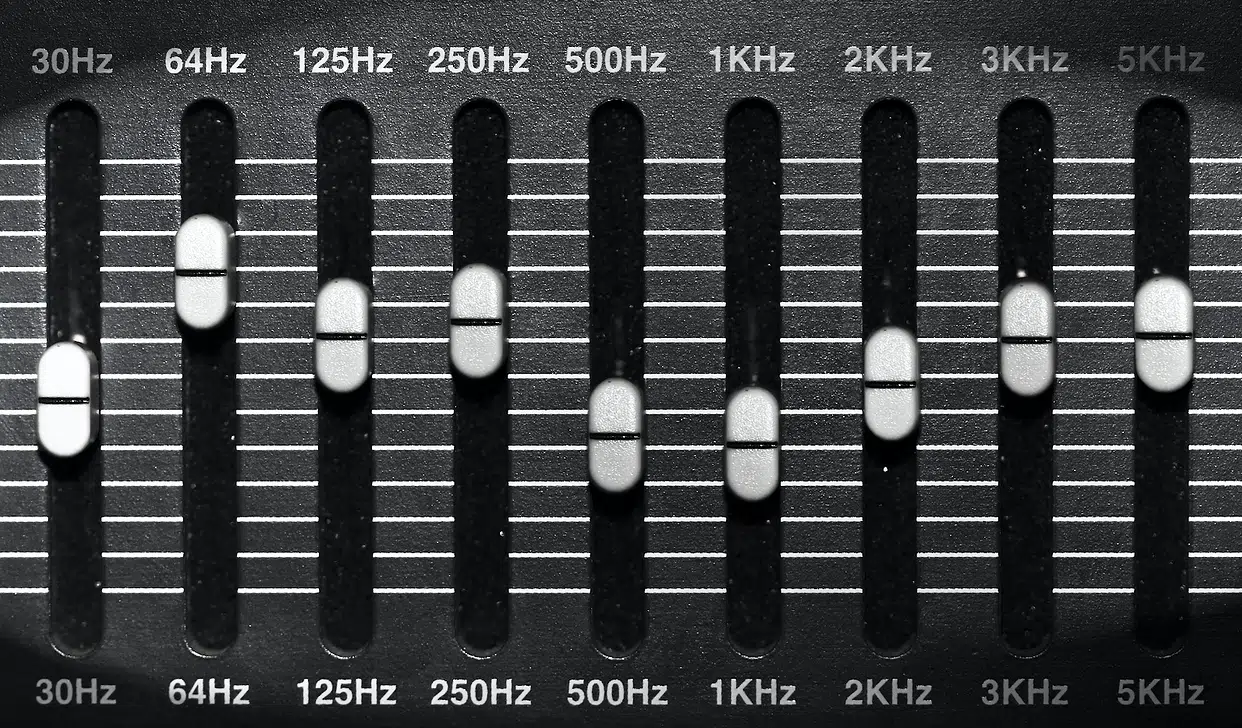
Different bass tracks often require different EQ settings.
- A bass guitar 一 A bass guitar might need a boost around 200Hz for some warmth.
- A synth bass 一 A synth bass might require a cut in the same region to prevent it from sounding too harsh.
Sub-bass frequencies (typically below 60Hz) add a sense of power to your mix, but too much can make your mix sound boomy or unbalanced.
Applying a high-pass filter to remove unnecessary sub-bass frequencies from non-bass instruments can keep your mix balanced.
As always, listen carefully and trust your ears with studio headphones…
If two bass tracks are clashing, try cutting a bit from one in the frequency range where the other shines.
This ‘give and take’ approach helps create a more harmonious mix.
-
Boosting Frequencies vs. Cutting Frequencies
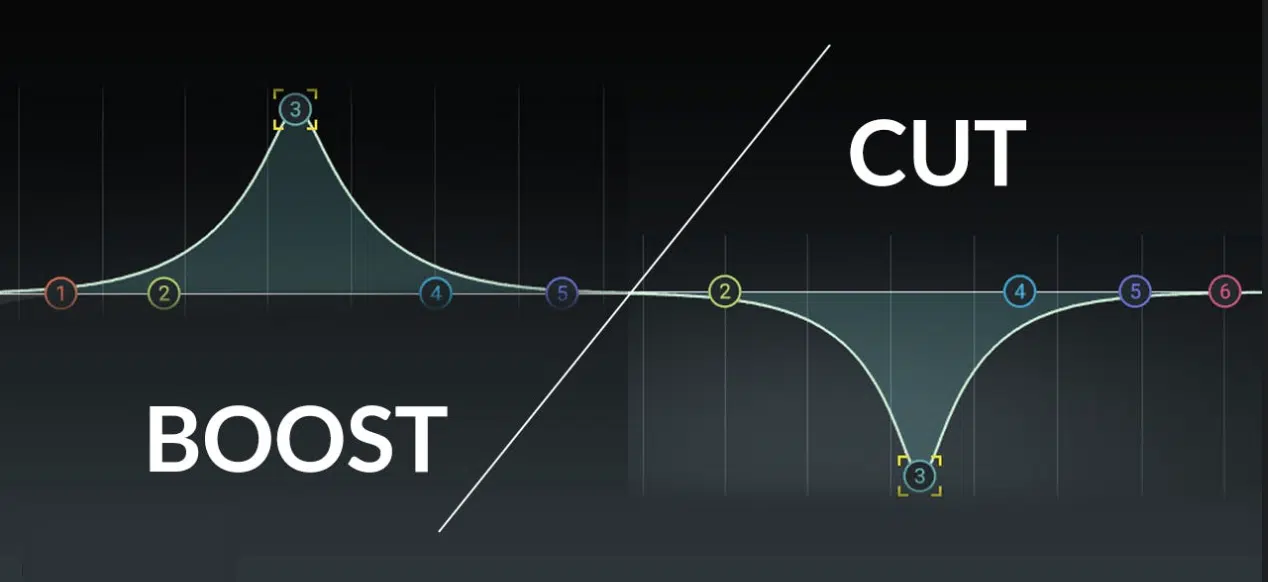
The ‘sweet spot’ in EQing is the frequency range where an instrument sounds its best.
For a bass guitar, it might be around 80-200Hz, while for a kick drum, it could be around 60-100Hz.
Identifying and subtly boosting these bass frequency ranges can make your instruments sound more vibrant and present.
However, boosting frequencies can increase the risk of a mix sounding muddy.
Hence, many studio engineers prefer to cut frequencies that are not needed to create space in the mix.
This is known as subtractive EQ, and it’s a great way to maintain clarity.
So, should you boost or cut?…
Well, it depends on the specific situation and overall goal.
- Boosting 一 Can bring out the best in an instrument
- Cutting 一 Often safer and cleaner
A balance between the two techniques usually leads to the best results.
And remember, the ‘sweet spot’ for your bass might change depending on the key of the song and the other instruments in your mix.
So, always listen in context and be prepared to adjust your bass EQ settings as needed.
PRO TIP
Bass traps are devices that absorb low frequencies and can help improve the accuracy of your room’s acoustics.
They’re especially beneficial if you’re working in a small or untreated room, where low frequencies can build up and create a false impression of your bass sound.
Whether you’re working with an electric bass or a bass drum, bass traps can be super effective.
-
The Power of the Sub Bass Roll in Creating a Dense Mix
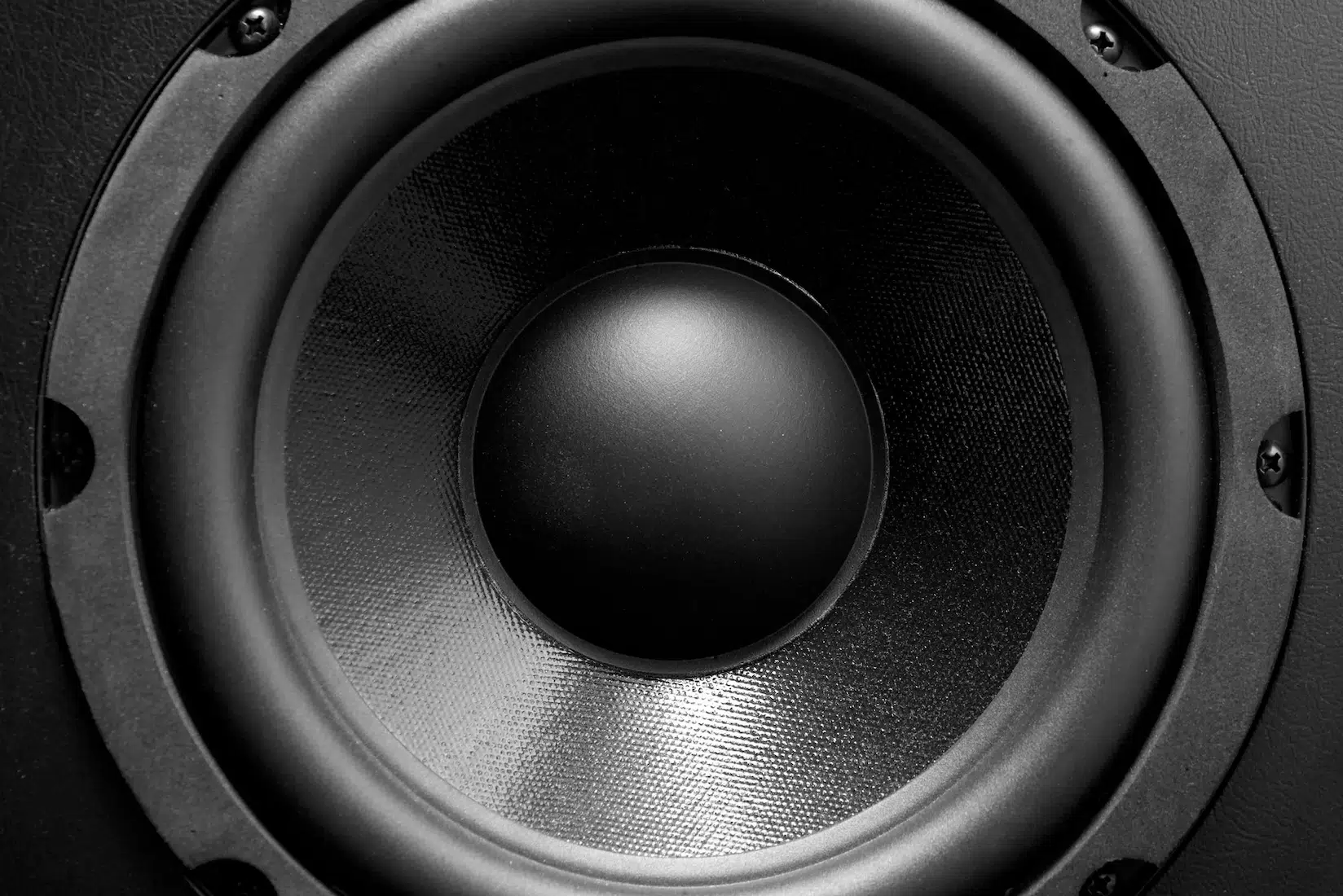
Sub bass, typically below 60Hz, is a powerful tool for adding depth and power to your mix.
A technique known as the ‘sub-bass roll’ involves boosting these sub-bass frequencies to make your mix feel bigger and denser.
However, the sub-bass roll requires careful handling.
Too much sub-bass can make your mix sound boomy or unbalanced 一 it can cause problems when played on smaller speakers that can’t reproduce these low frequencies.
A good way to control your sub-bass is to use a high-pass filter with a gentle slope.
This allows some sub-bass through but taming excessive rumble.
NOTE: Compressing your sub-bass can also help keep it consistent and prevent it from overpowering your mix.
-
Carving Space in the Frequency Range
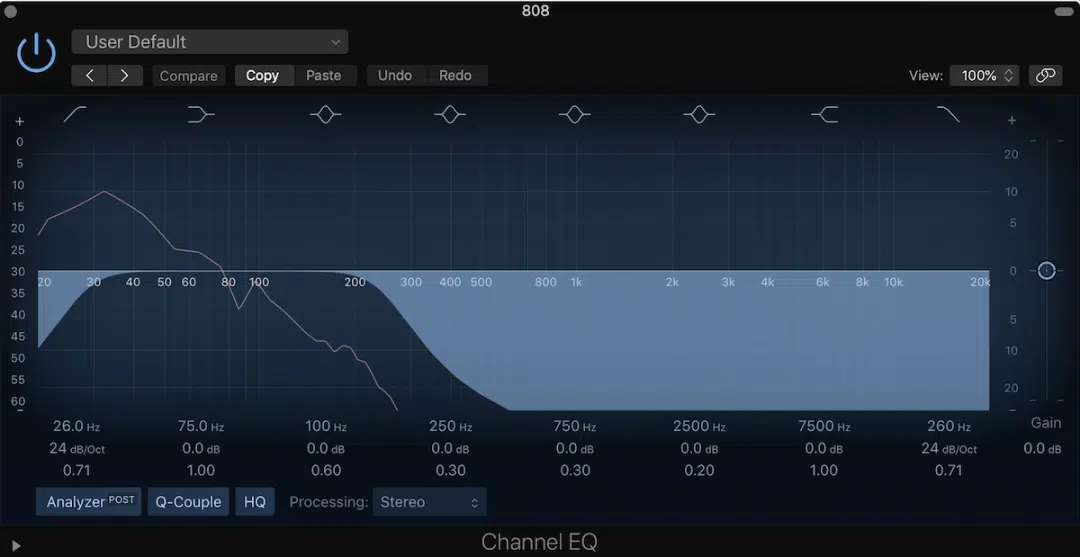
The frequency range of a mix is like a canvas.
Just as a painter cannot put two colors in the same spot without blending them, two other instruments cannot occupy the same frequency range without merging.
This process of ‘carving out space’ for each instrument is essential to a clean mix.
For example, if your bass guitar shines at around 100Hz, you might want to apply a slight cut at this frequency on your kick drum.
This allows each instrument to have its ‘own space’ in the mix and reduces frequency masking 一 where one instrument obscures the sound of another.
The key is subtlety.
Rather than making dramatic cuts, try gentle, broad cuts and boosts to carve out space.
This maintains the natural sound of your instruments while ensuring they work together harmoniously.
Balancing Kick Drum Sounds with Bass Frequencies
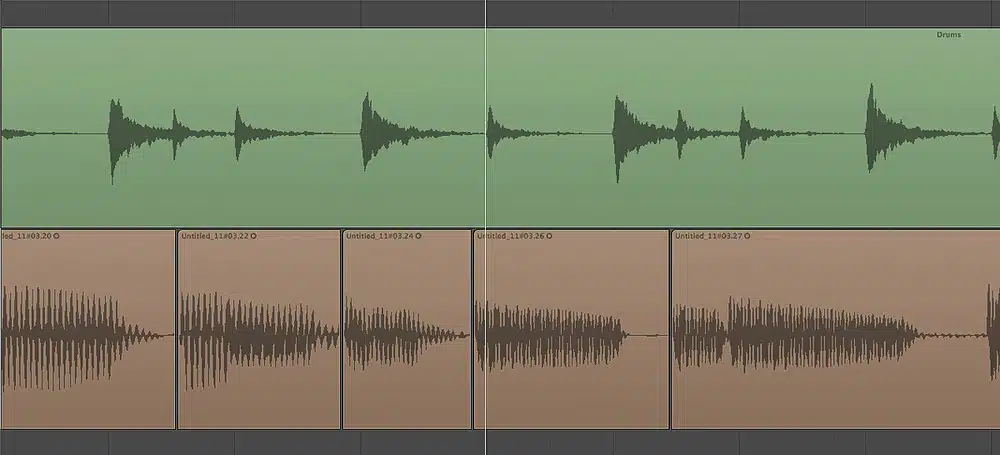
The relationship between the kick drum and bass is critical in most genres, especially in rhythm-focused genres like hip-hop and dance music.
Both occupy similar frequency ranges, so careful EQing is required to prevent them from clashing.
One common technique is to determine which element you want to be more dominant in the low frequencies.
- If you want a bass-heavy mix 一 Cut some of the low-end from your kick, allowing the bass to shine.
- If your kick is crucial 一 The opposite applies.
Once you determine what you’re main focus is, you can apply EQ accordingly.
Complementary EQ is another technique.
If your kick has a significant frequency peak at 80Hz, consider carving out a slight dip at 80Hz on your bass track.
This allows the kick to punch through the mix without affecting the overall bass presence.
How Sidechain Compression Helps in Mixing Bass & Kick Drum
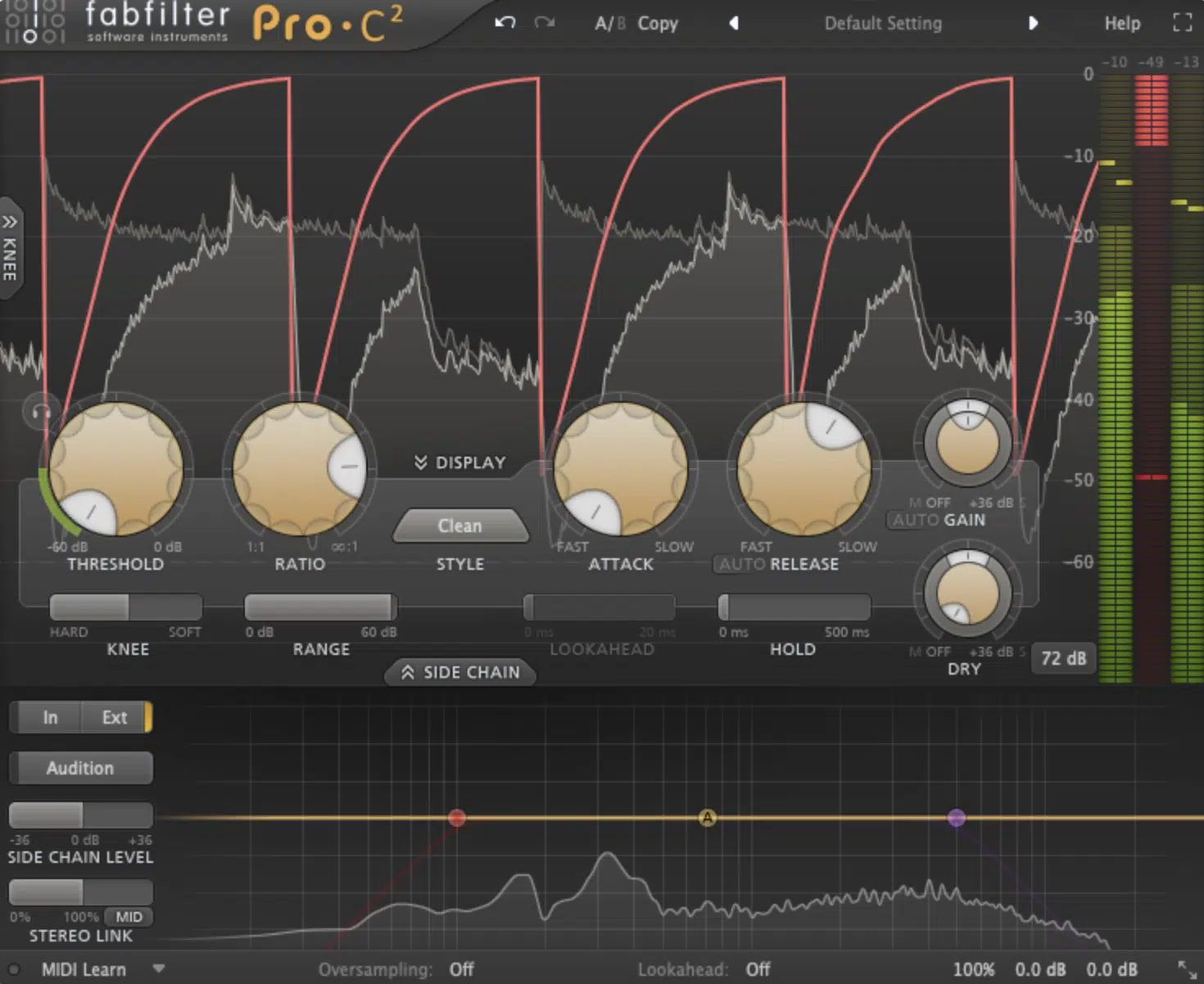
Sidechain compression is a technique that reduces the level of one audio signal based on the volume of another.
In the context of bass EQing, it’s often used to ‘duck’ the bass when the kick drum hits 一 allowing the kick to cut through the mix clearly.
When the kick drum triggers the sidechain compressor, the bass volume dips momentarily (creating a rhythmic ‘pumping’ effect).
This effect can be subtle, just enough to let the kick through, or more pronounced for a stylistic audio effect.
While not strictly an EQ technique, sidechain compression can help manage low-end frequencies and prevent the bass and kick from clashing.
However, it should be used judiciously, as excessive sidechain compression can lead to an unnatural sound, and you always want to make sure your track sounds good.
The Role of Frequency Response: When Your Mix Lacks Clarity
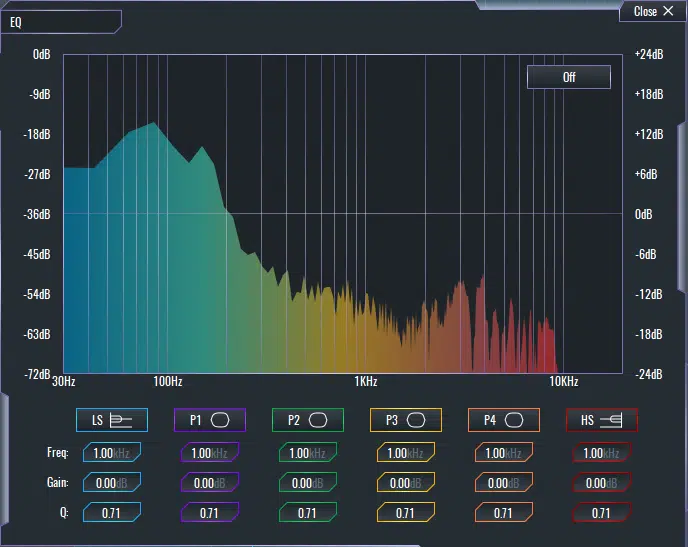
If your mix lacks clarity, it might be due to poor frequency response; the range of frequencies that an audio system can reproduce.
Poor frequency response can result from various factors, including:
- Improper room acoustics
- Low-quality speakers
- Even your own hearing
A lack of clarity in the bass frequencies can often be fixed with careful EQing.
High-pass filters can be used to remove unnecessary low frequencies from non-bass instruments, cleaning up the mix.
Complementary EQ can also help by ensuring that each instrument has its own space in the frequency spectrum.
If your room or speakers have a poor frequency response, you might want to consider investing in better equipment or acoustically treating your room.
Remember, even the best EQing techniques can’t compensate for a room that’s causing significant frequency coloration.
Bonus: Advanced EQ Techniques
Now, let’s explore some advanced EQ techniques to take your bass mixing skills to the next level.
-
Exploring the Potential of Sub Bass Frequencies
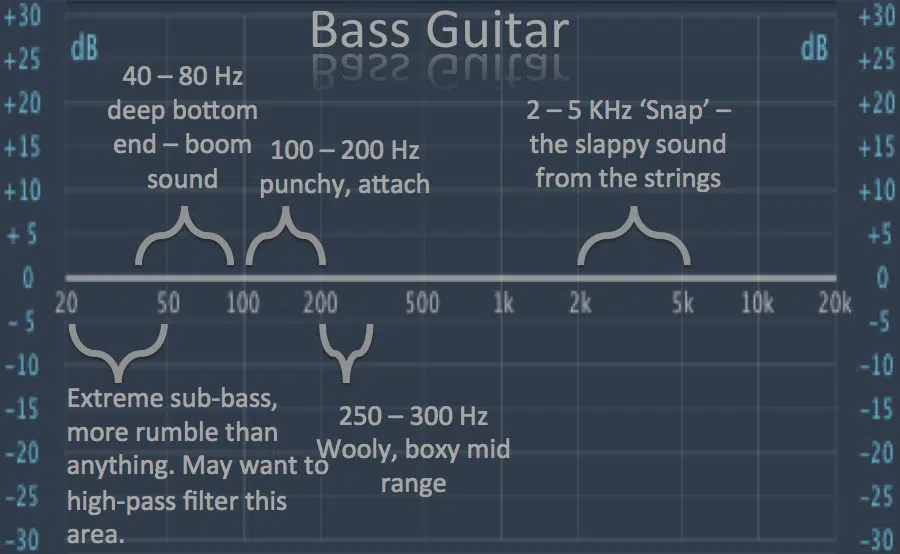
Sub-bass frequencies, usually below 60Hz, can provide a feeling of power and depth to a mix.
However, they can be challenging to control, and not all playback systems can accurately reproduce these frequencies.
Harmonic enrichment can be a way to make the sub-bass more audible on smaller systems.
This technique involves adding harmonic content to make the bass perceptible even if the fundamental frequency is too low to be reproduced accurately.
NOTE: Harmonic enrichment refers to frequencies that are multiples of the fundamental frequency.
Subtle saturation or distortion can also be used to add harmonics and make the bass more audible.
Remember, the goal is not to create a distorted bass sound.
It’s to add just enough harmonics to improve the perceived bass on systems that struggle with low frequencies.
-
Using a Frequency Analyzer for Precision
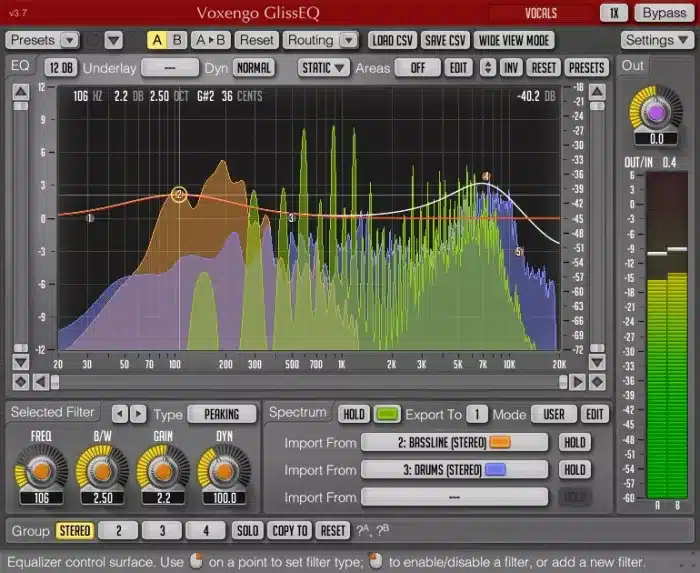
Frequency analyzers can be a secret weapon in your mixing arsenal.
These tools provide a visual representation of your mix’s frequency spectrum, making it easy to spot problems that you may not hear.
An analyzer can help you identify:
- A build-up of certain frequencies
- Areas where your mix is lacking
- Frequency masking can all be identified with an analyzer
For bass EQing, an analyzer can help identify where your bass sits in the frequency spectrum and where it might be clashing with other instruments.
As well as whether there’s too much or too little bass.
It’s a powerful tool for making precise EQ adjustments, just remember that your ears are the final judge.
The analyzer is just a tool to aid your decision-making process, not dictate it.
-
Surgical EQ
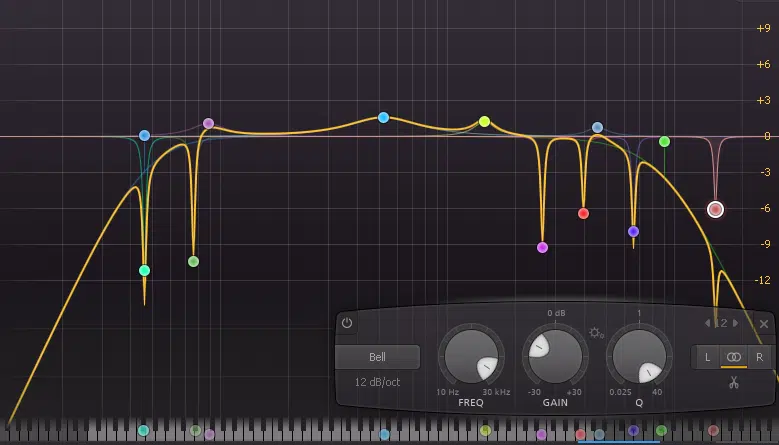
Surgical EQ is a type of equalization used to make precise, narrow adjustments to the frequency spectrum.
It’s often used to remove problematic frequencies, like:
- A resonant frequency that’s causing feedback
- A particular frequency that’s clashing between two instruments
For bass frequencies, surgical EQ can be helpful for removing rumble or hum.
For example, if you have a bass guitar track with a hum at 60Hz, you could use a narrow cut with a high-Q value to reduce that frequency.
This minimizes the hum without affecting the rest of your bass sound.
NOTE: Surgical EQ should be used sparingly and only when absolutely necessary.
Overuse of surgical EQ can make your entire mix sound unnatural or thin, and you always want to make sure it sounds balanced.
Always use your ears to guide your decisions, and remember that sometimes a ‘perfect’ frequency balance isn’t the goal.
How to EQ Bass: Final Thoughts
Mastering the art of EQing bass is a critical aspect of music production, especially in genres like hip-hop where bass serves as the driving rhythmic force.
It’s not just about getting the right notes but how you shape those notes in the mix, carve out space for them, balance them with other instruments, and troubleshoot any issues.
Every step, from understanding the role and nuances of bass to utilizing advanced EQ techniques, plays a significant role in shaping your final sound.
But like any other skill, EQing bass requires not just theoretical knowledge but also hands-on experience.
The more you practice, the better you’ll understand how different frequencies interact and how to craft a rich, clear, and balanced mix.
That’s why resources like these insanely addicting free bass loops are such invaluable tools.
They provide you with 12 unique, fire basslines to practice your EQing skills on, all professionally crafted and perfectly mixed.
Plus, since they’re free, you can start applying everything you’ve learned in this guide right away, without having to worry about crafting the perfect bassline from scratch.
You can experiment with different EQ settings, try out different techniques, and really get a feel for how EQing impacts the sound.
By combining the knowledge you’ve gained from this guide with practical experience using tools like these bass loops, you’ll know how to EQ bass like a boss in no time.
Until next time…







Leave a Reply
You must belogged in to post a comment.